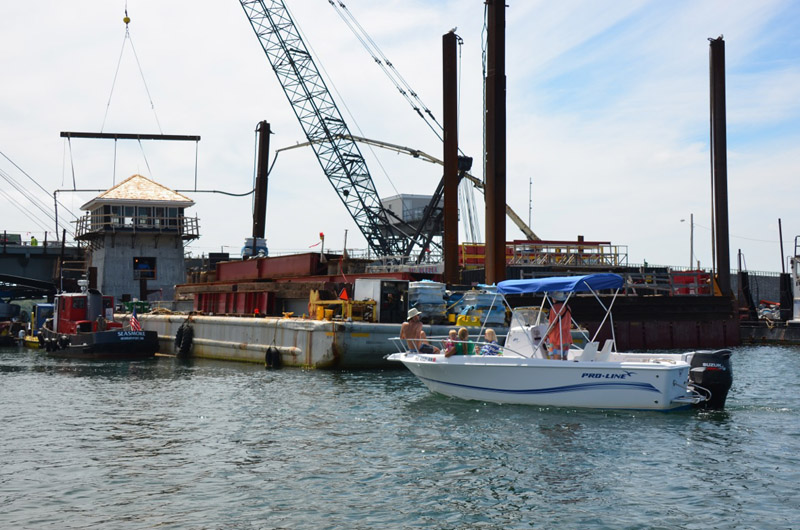As the years-long, hugely expensive Lagoon Pond drawbridge project enters its final phase, state contractors confirmed this week that the bridge will stay in the down position from Oct. 1 to Jan. 31. The reason is to allow timely completion of the permanent bridge. Signs were recently posted around the bridge notifying mariners; once the bridge is down it effectively will prevent entry or exit from the pond for most sailboats and larger motor vessels. Vessels 15 feet in height or less may still pass underneath the span.
Middlesex Corporation, the contractor, and Massachusetts Department of Transportation officials said this week that the new bridge is on schedule for completion in December. The temporary bridge must be removed by Jan. 31 in order to comply with environmental regulations that protect the spawning season of winter flounder.
“They wanted more time, but we wanted everyone to have as full a summer as possible,” said Melinda Loberg, a Tisbury selectman and chairman of the Lagoon Pond drawbridge committee. “We’re trying to get the word out. All the shipyards have been notified to make sure their customers know about it.”
Explaining the technical details, Mrs. Loberg said the temporary bridge must remain in the down position so that work crews can finish construction of the final sections of the permanent bridge, including a walkway and platform planned for the new bridge. The two bridges were built within a few feet of each other.
The closure covers all of October and November, the last two months of hurricane season. Lagoon Pond is considered one of the safest places in New England to ride out a big storm and many larger vessels head for the protected waters when a storm is forecast.
Historically, most large storms strike New England before the scheduled Oct. 1 closure. September is the month when most hurricanes and tropical storms hit New England. Since 1869, only five hurricanes or tropical storms have hit the Island in October, and none in November. Still, the possibility of big storm worries some.
“I kicked and screamed a little bit in the beginning,” said Tisbury harbor master Jay Wilbur. “There will still be access for small working boats. The scallop fleet will be able to pass through. We’ll just roll with it. We don’t love the idea, but it’s certainly an important project.” Mr. Wilbur said all boats must be in or out of the Lagoon by the Oct. 1 deadline. “Will there be a few people that will get stuck, sure,” he said. “I’ll have to deal with that.” Under the terms of the contract, the construction firm cannot close all vehicle traffic lanes, and there are no plans to restrict traffic to one lane for any extended period. However, MassDOT warns motorists to expect temporary lane restrictions until construction is complete.
Planning for the temporary bridge began in 2003 and construction began in November 2007. That span opened to traffic in January 2010 and cost $10.3 million. Construction of the permanent bridge featuring a wider, straighter channel, began in the summer of 2013, and is on schedule to be complete in December. The projected cost of the permanent bridge, according to state records, is $43.7 million.
The original bascule drawbridge, built in 1935, was notoriously unreliable, sometimes failing to close completely in the down position, halting traffic over the busy roadway. That unreliablity was cited by the Lagoon Pond bridge committee as the main reason a temporary span was necessary. Committee members said if the bridge failed completely while a new drawbridge was under construction, it would force closure of the main route from Vineyard Haven to Oak Bluffs for an extended period. The bridge also lies on the main route used by emergency vehicles coming from Vineyard Haven and up-Island to the Martha’s Vineyard Hospital.
“If anything happened, if it failed in any way, the Coast Guard was going to make them keep the [old] bridge open for marine traffic,” Mrs. Loberg said. “That was something the Island felt they couldn’t tolerate.”








Comments
Comment policy »